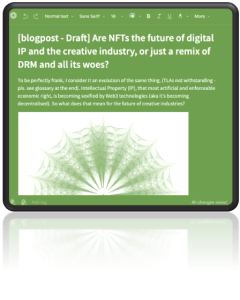Are NFTs the future of digital IP and the creative world, or just a remix of DRM and all its woes? (Part 1)
To be perfectly frank, I consider it an evolution of the same thing, TLAs not withstanding (pls. see glossary at the end). Intellectual Property (or IP), that most artificial and enforceable economic right, is becoming somewhat sexified by Web3 technologies and new opportunities for decentralisation. So what does that mean for the future of creative industries?
Over the holidays, I indulged in a little experimentation and research into blockchain applications, crypto and NFTs in particular. The latter sparked a fire because of its connection to my favourite topics of digital content, technology and intellectual property, so I just had to write about it. This is first in a series of posts drafted over that period to share some observations, opinions and conclusions. They are broken down into the following:
- What are NFTs (and the non-fungibility superpower)?
- What has this got to do with Intellectual Property (and content protection)?
- Does it mean that NFTs are like DRM remixed?
- How does it affect the creative industry today and in the future?
- Summary observations and conclusions.
1 – What are NFTs (and the non-fungibility superpower)?
As the name implies, a Non-Fungible Token (or NFT) is not inter-changeable with any other and is therefore unique. This remarkable quality may be considered as the NFT’s superpower in a world of digitally perfect copies, and otherwise fungible or exchangeable items. It also resonates with our real-world, scarcity-driven value systems and economics.
NFTs are defined in Ethereum’s ERC721 standard. Ethereum is a programmable blockchain that builds on the innovation of Bitcoin with capabilities (e.g. smart contracts) to deliver a whole lot more than mere cryptocurrency. For example, Ethereum can be used to create: Decentralised applications (DApps), Decentralised Finance (DeFi), Decentralised Autonomous Organisations (DAO), and of course, NFTs.
Under the covers, an NFT is just a piece of metadata that points to something, (e.g. an image file), which is usually stored on a server on the internet. Note: the stored item are not NFTs, just the metadata that links them. Hmmm!
NFTs can be created (or ‘minted’), transferred, and/or sold, with each transaction recorded on the blockchain. This allows what is widely referred to as minimal trust transactions – i.e. you do not need to know or trust the counter-party with whom you are interacting. NFTs can be bought or sold via exchanges, (such as: OpenSea, Rarible, Nifty Gateway, or SuperRare etc.), and they have become famous as investable / collectible items. This is usually based on certain valuable attributes, such as: uniqueness or rarity (e.g. first editions), utility value (e.g. access to events), or ownership history (e.g. a previous celebrity owner).
Finally, The NFT’s smart contract provides an inbuilt royalty mechanism which can be programmed to pay original creators and owners a portion of the resale value of their NFTs, in perpetuity. This is a particularly interesting feature because it is provides a great way to monetise the rights of the original creator or owner of an NFT.
In Part 2, we’ll take a look at what this means in the context of Intellectual Property. Stay tuned.
Disclaimer: The opinions expressed in this post are mine alone, and do not reflect those of my employer or professional associations in any way, shape or form. Secondly, it does not constitute any legal, financial, spiritual or otherwise professional advice, and I do not claim any specific expertise on these topics. Furthermore, I believe, we’re still very early into these particular digital technologies and their fast emerging use cases, therefore it is advisable to proceed with caution.
Pls. Note: As part of my education, research, and experimentation, I purchased a couple of NFTs and even minted a few pieces on OpenSea, (the above NFT image is based on an early draft of this article). It is used here for illustration and critique purposes only.
Glossary (in case you are unfamiliar with some of the terms and abbreviations used):
- NFT – Non Fungible Token
- DAO – Decentralised Autonomous Organisations
- Dapps – Decentralised applications
- DeFi – Decentralised Finance
- DRM – Digital Rights Management
- ERC – Ethereum Request for Comments
- EIP – Ethereum Improvement Proposals
- IP – Intellectual Property
- TLA – Three Letter Acronym
- Web3 – another name for decentralised web, powered by blockchain technology
-
January 23, 2022 at 11:57 pmAre NFTs the future of digital IP and the creative world, or just a remix of DRM and all its woes? (Part 2) | Judeumeh's Blog
-
February 5, 2022 at 4:28 pmAre NFTs the future of digital IP and the creative world, or just a remix of DRM and all its woes? (Part 3) | Judeumeh's Blog
-
February 6, 2022 at 11:42 pmAre NFTs the future of digital IP and the creative world, or just a remix of DRM and all its woes? (Part 4) | Judeumeh's Blog
-
February 15, 2022 at 1:27 pmAre NFTs the future of digital IP and the creative world, or just a remix of DRM and all its woes? (Part 5) | Judeumeh's Blog
